For backcountry skiers and splitboarders looking for a higher-volume, low-weight electronic airbag, Ortovox’s AVABAG Litric Tour 40 is one of only a few options. The pack utilizes the LiTRIC system, a lightweight electronic airbag system co-developed by Ortovox and Arc’teryx that’s been tested and mostly praised by several WildSnow contributors since it debuted in 2022.
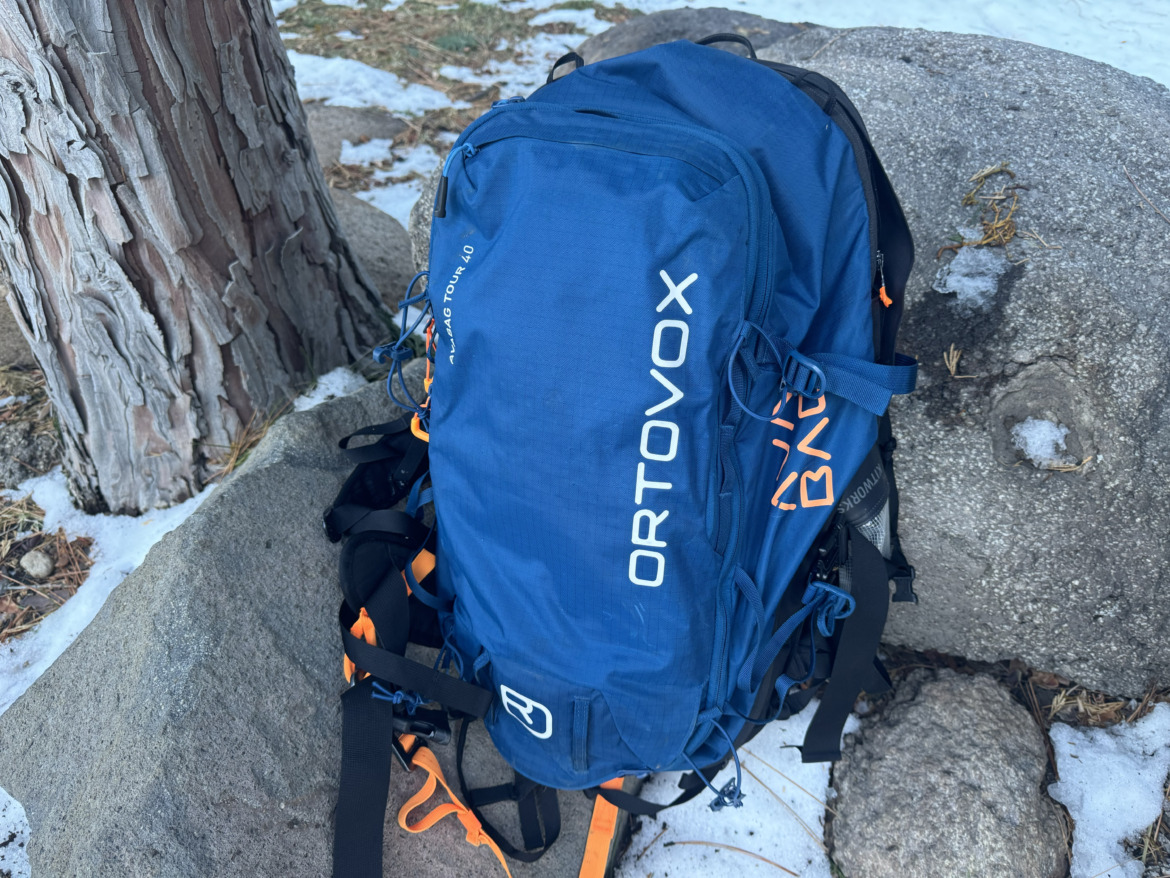
Here, Tahoe-based splitboarder Drew Zieff analyzes the pros and cons of this Ortovox avalanche airbag–like a forecaster ogling rounded snow grains through a magnifying loupe—and overall recommends it for frequent flyers, guides, and anyone looking to haul a sizeable load and an airbag while minimizing the weight penalty.
Why Electric? The Case For Ditching The Canister Has Never Been Stronger
As mentioned in my review of BCA’s E2 Float 35, I’ve always gravitated toward electric airbags. Why? Primarily because compressed air cylinders are a nuisance to fly with, and traveling to shred is my favorite pastime. Traveling with compressed air packs means emptying canisters before your flight, and then refilling them upon arrival. In lesser-traveled zones—the exact types of off-the-beaten-path destinations that call to the backcountry skier—finding somewhere to pull this off is usually impossible. At best, you’re burning trip time on getting a refill.
The ability of electronic airbag systems to fire off multiple deployments on a single charge provides peace of mind you don’t get with a single-use canister. This allows you to practice pulling your airbag to ensure functionality ahead of your trip. In the event of a deployment on a longer mission (say, a multi-day hut trip), you can quickly deflate, reset, and be ready to continue. If your exit passes through avalanche terrain, this is a major benefit.
There are two main reasons electronic airbags didn’t completely take over the market when Black Diamond introduced its Jetforce packs a decade ago: weight and cost. Early iterations were heavy as hell and pricey. The airbag systems themselves were bulky, too, taking up more pack volume than manufacturers cared to admit.
Electronic airbags have evolved and improved, becoming lower-profile, lighter, and more efficient. Case in point: the Ortovox Avabag Litric Tour 40 weighs in at a manageable (claimed) 5.42 pounds (my cheap luggage scale has it clocking in at 5 pounds, maybe a hair under). Granted, the price tag is wild at $1,400, but it’s cheaper than Arc’Teryx’s LiTRIC Micon 42, a similarly specced albeit slightly lighter option Bergen Tjossem just reviewed for Wild Snow.
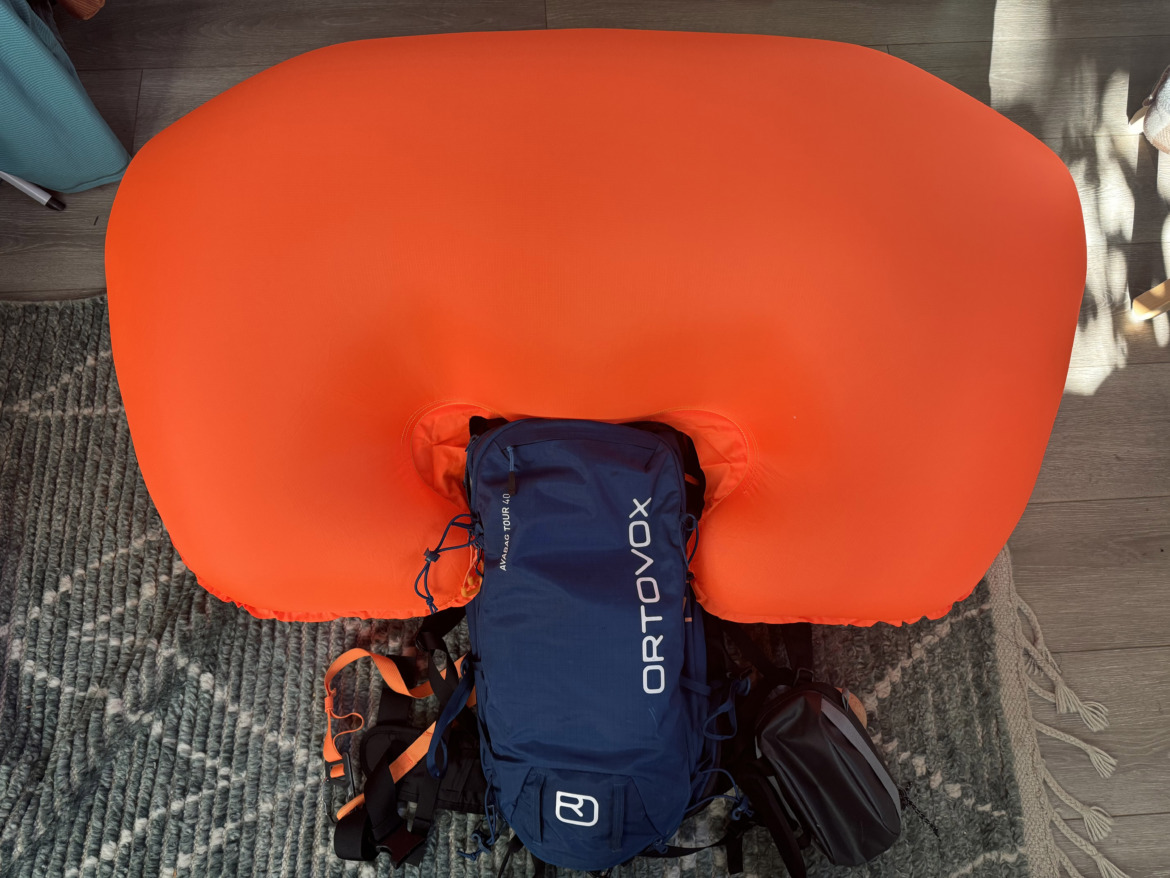
Pretty easy to inflate, deflate, and repack the Ortovox LiTRIC pack.
Why I’m Loving The Ortovox Avabag LiTRIC Tour 40: The LiTRIC System
Two electronic airbag systems dominate the market right now: the Alpride E2, which you’ll find on Deuter, BCA, Scott, and Osprey packs, and the LiTRIC, which is proprietary to Ortovox and Arc’teryx. I get into the weeds of the differences between the Alpride and LiTRIC systems a little more in this review of BCA’s E2 Float 35, but there are several noteworthy selling points of the LiTRIC. Most notably, it keeps the weight as low as possible.
As Light As It Gets
The LiTRIC system (not including the pack) is lighter than the Alpride E2 system by 90 grams. Not much, but if you’re reading a two-thousand-plus-word airbag review on Wild Snow, chances are you’ll appreciate those grams. If you’re looking for the lightest-weight electronic airbag system you can get, this is the way to go. Note that this pack isn’t as light as more streamlined Ortovox options, like the Litric Zero 27 (4.34 pounds) or the pricier Arc’Teryx Micon 42 (4.85 pounds).
Airbag Configuration And Positioning
I found that the internal positioning of the LiTRIC airbag pocket (where the deflated airbag is stored) and airbag fan unit is preferable for making the most of your pack volume. The airbag pocket is about the size and location of a goggle pocket on a non-airbag touring pack, and the fan sits just below it on the looker’s left side of the pack. I like that positioning, as it frees up the bottom of the pack so you can pack bulky things like Nalgenes, RAD bags, crampons, etc without a fight.
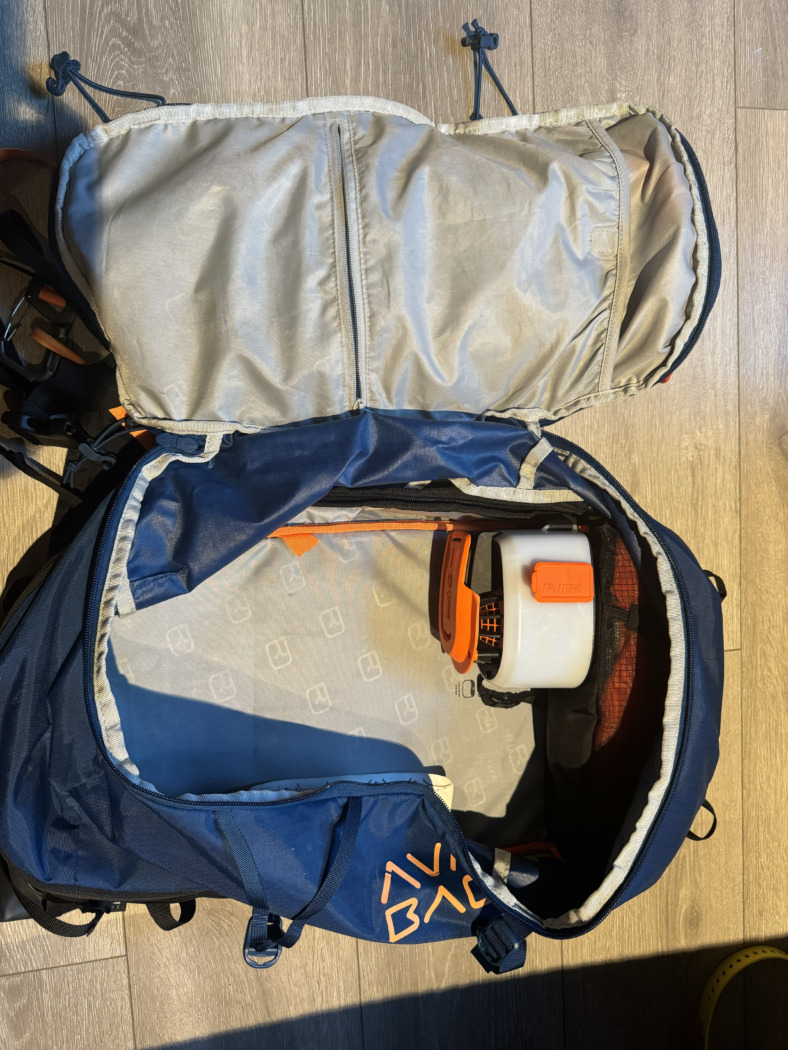
I tested this pack on a three-week trip to northern Norway last spring, which included day trips when I was bringing all of my sharp shit and a 10-day expedition through the fjords of Finnmark with Upguides. Even on the bigger, colder days, when I’d pack my light puffy and a heavier emergency layer, two water bottles and plenty of food, splitboard and boot crampons, I wasn’t playing tug-o-war with zippers to open or close pockets. I credit this to the pack design (more on this below), but the airbag configuration also deserves kudos.
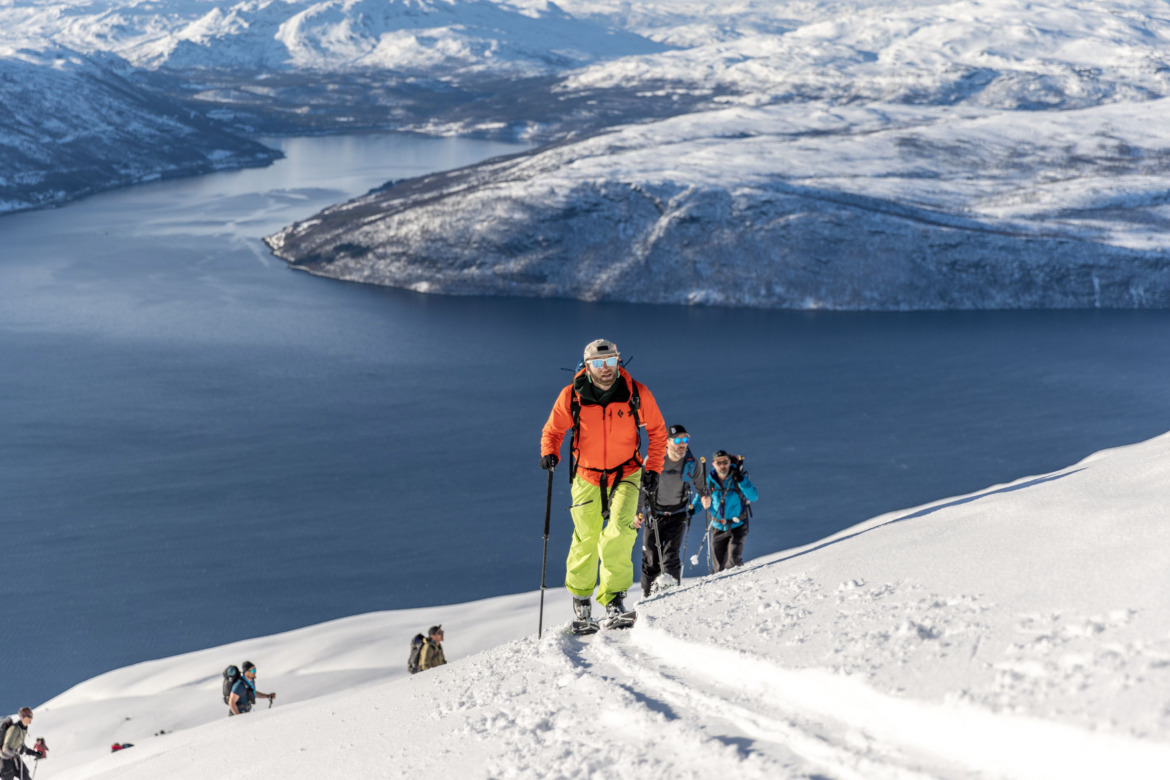
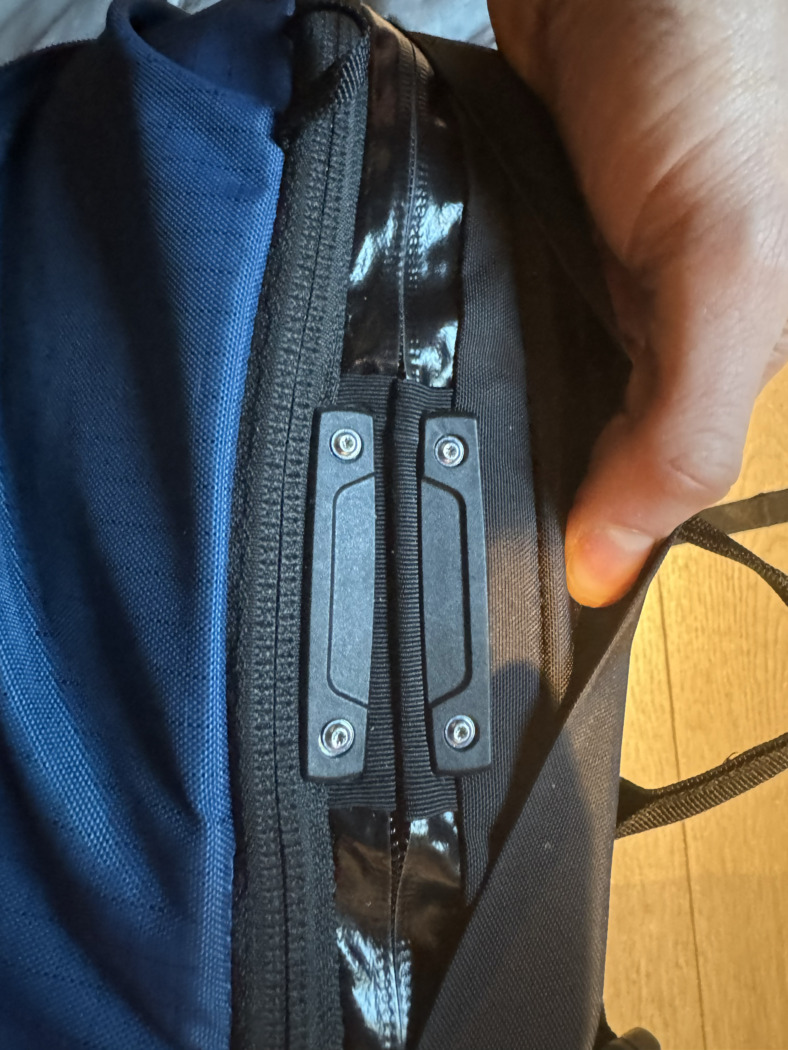
locking mechanism ensures the airbag pocket stays shut
Solid Airbag Pocket Closure Mechanism
If you’re planning to overstuff this bad boy on bigger days or overnight trips, there’s another helpful design feature: the avalanche airbag closure is secured via a latch, not just a zipper. If you’ve ever had issues closing your airbag pocket or, more likely, having the airbag pocket zipper flop open while touring or descending (a major annoyance, at least for me), you’ll dig this feature. Even after super long days with a fully loaded pack and throughout the expedition, I never had the airbag pocket pop open.
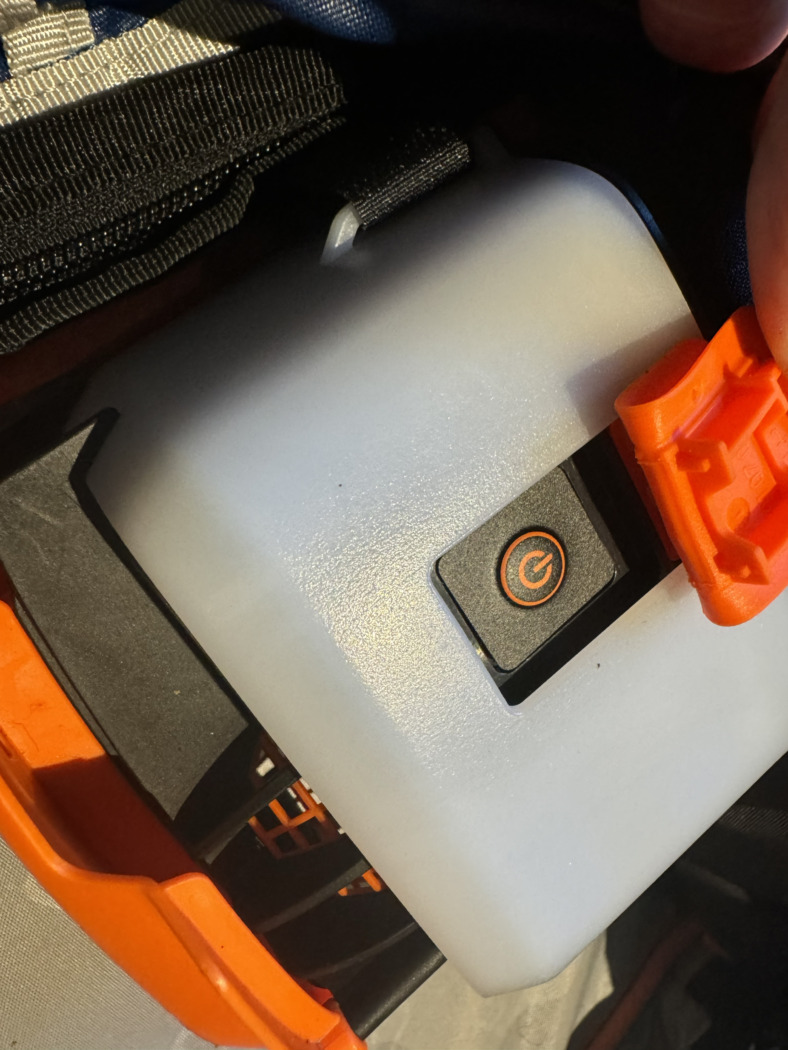
On-Off Button
Last but not least, I also like the on-off button of the Litric compared to the pull toggle of the Alpride E2 (it’s just a little easier, not a dealbreaker either way).
Critiques of the Litric System
I’ve found a couple of fiddly aspects of the LiTRIC design worth pointing out. These aren’t full-blown negatives, just minor critiques you may or may not share if you get one.
Checking Your Battery
To check the battery life of the Litric system, you look at the side panel of the backpack, where you’ll see a sequence of flashing lights. The Alpride E2 system, on the other hand, has both flashing lights visible through the side panel and an internal LCD screen that shows a diagram of battery life with bars representing power. This Alpride E2 screen shows both the battery life of the supercapacitors (the electromechanical component that fires the airbag) and the lithium-ion battery that re-powers the supercapacitors after a deployment. It’s a preferable feature, but it could also be part of the reason why the Alpride system is a little heavier.
Lithium-Ion Battery vs. AA Batteries
The biggest difference between the Alpride E2 system and the LiTRIC system is how the supercapacitors are topped off after a deployment. The Alpride system uses AA batteries, while the LiTRIC system has a built-in lithium-ion battery.
Ortovox claims the LiTRIC system provides 60 hours of battery and at least two deployments per 25-minute charge. I had no problem with the battery life of the LiTRIC system on my Norway expedition. I charged the pack before I left and was able to use it throughout a 10-day trip, which included some brutally cold temperatures. I was careful with use though, turning off the airbag overnight and on mellow camp-to-camp tours that didn’t pass through avalanche terrain to ensure I’d have juice til the end of the trip.
Some skiers and splitboarders, especially ones on longer expeditions, might prefer the AA battery-style rechargeability of the Alpride E2 system. If you always bring a solar panel or a power bank with USB-C on longer expeditions, this isn’t as relevant. Topping off the LiTRIC’s lithium-ion battery is pretty quick and easy if you have a power source.
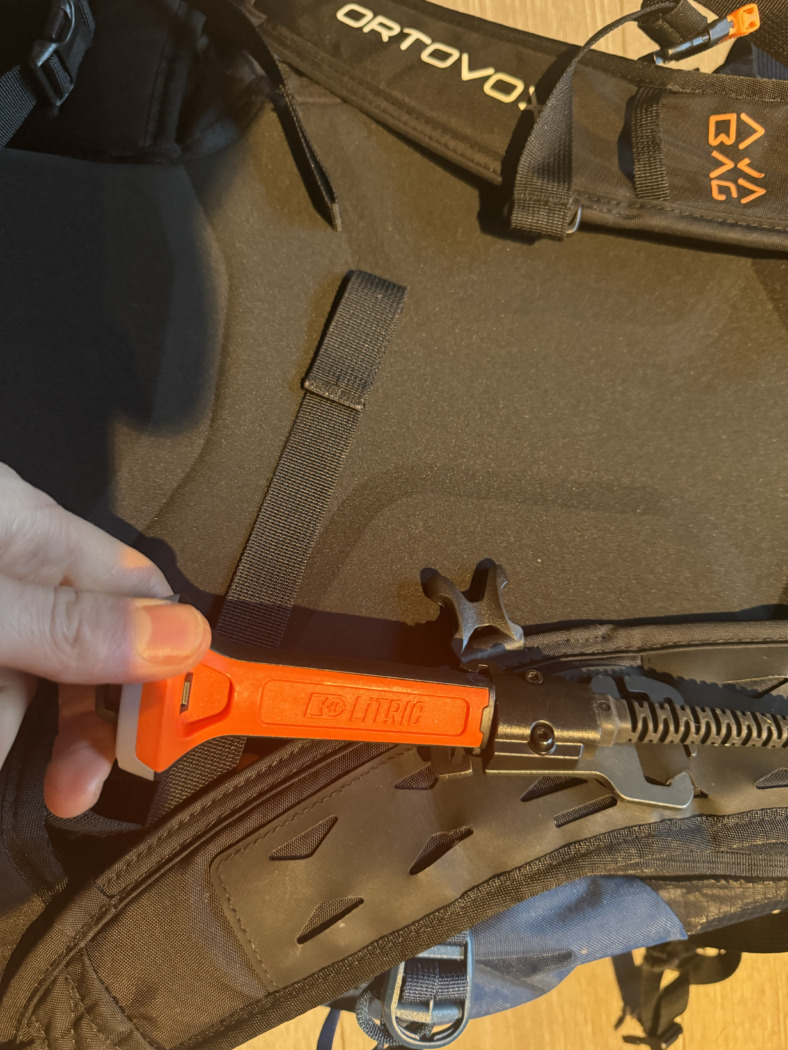
Minor LiTRIC Handle Gripes
The LiTRIC system features a pull handle that is easily adjusted to the left or right shoulder strap. It also boasts a nifty twist system that locks or unlocks the airbag pull and is visually obvious—orange is ready to rock, black is locked. That handle is easily twisted with gloves or mitts on and the twisting feature is one of my favorite aspects of the system. So—where’s the beef?
My one complaint here is the handle can’t be zipped up into the backpack strap. This seems to be the case for all LiTRIC airbags, versus the BCA Float E2 35 I just tested, which has a handle that can be zipped into the shoulder strap. Bergen asked Arc’teryx about the LiTRIC handle for his Arc’Teryx Micon 42 review and they said leaving it permanently out is an effort to combat the common problem of users forgetting to pull the handle out before descending (which obviously defeats the purpose of wearing an airbag pack).
That’s admirable, but I like the stowability on the E2 for travel, as it makes the pack less conspicuous and protects the airbag system in transit. More importantly, on snow, it’s a practical option to have. If I’m hitting a jump, hiking along a cliff, or dropping a pillow line that merits a haphazard 360, I might be more concerned with an accidental deployment than an actual avalanche.

pulk towed behind the Ortovox AVABAG LiTRIC Tour 40 in Norway
What I Love About the Ortovox AVABAG LiTRIC Tour 40 Backpack
The Perfect Balance of Low Weight, High Volume
Considering the volume of the pack and the airbag within, the Ortovox offers gram-counters excellent bang for buck at a claimed 5.42 pounds (again, my luggage scale clocked a little lighter). Thanks to the LiTRIC system itself, judicious pack design (some features, but not too many), and use of lightweight-yet-strong materials, the designers kept pack weight very manageable.
I think the biggest compliment I can give here is that I used this pack on many tours when avalanches weren’t a concern (it was the only pack I brought on my 10-day expedition, after all, and we enjoyed a mostly stable spring snowpack). Despite that, I never found myself wishing that I’d brought an ultralight, airbag-less backcountry pack.
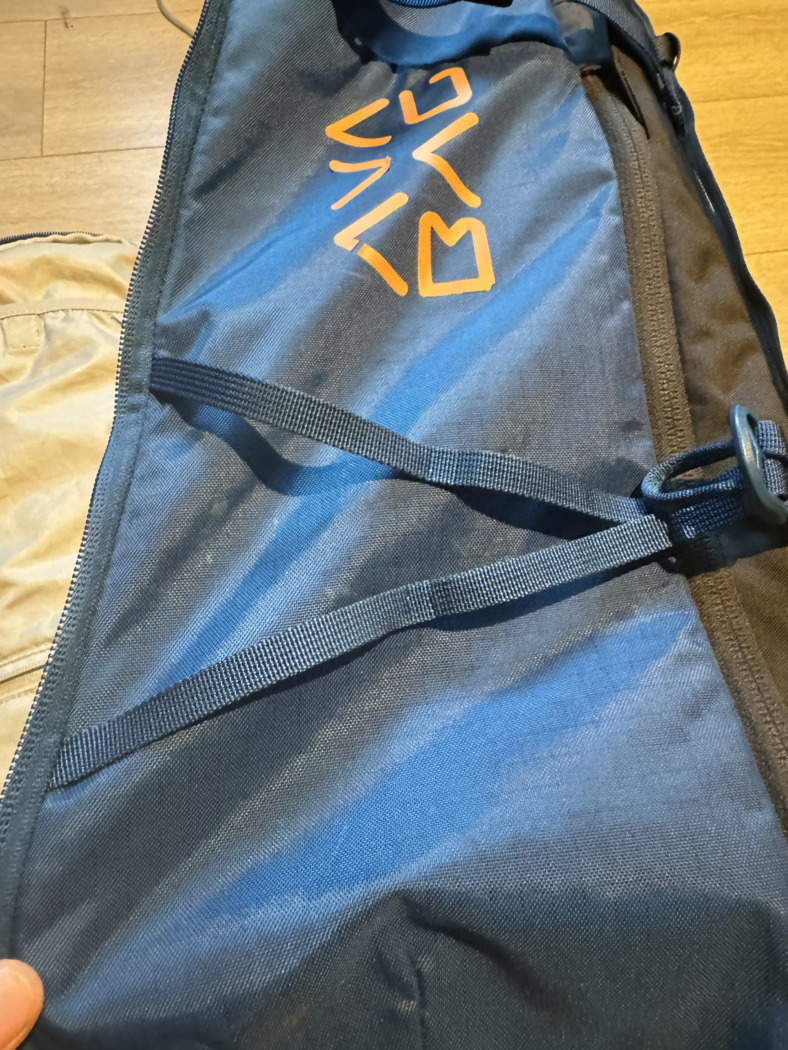
Best-In-Show Compression Straps
Most of the time, I don’t need a full 40 liters of volume, so I appreciate being able to cinch a larger pack down. The Tour features a well-designed set of compression straps that allow you to reduce volume for better downhill performance. In particular, I dug the lower triangular strap–it’s quick to pull, secure, and distributes compression evenly. These straps are also swell for stashing poles (see my recent Wolverine Split Sticks review).
Comfortable, Reliable Carry System
I spent a bunch of days in the backcountry with Ortovox’s AVABAG Litric Tour 40 fully loaded and a few more lugging an overpacked Pulk sled behind it. The padded shoulder straps and hip belt are comfortable, and I didn’t have any pressure points on long days.

Touring with the Ortovox LiTRIC Tour 40 in Tahoe. Photo credit: Gloria Liu
Excellent Main Compartment With Dual Access Points
As I mentioned above, the airbag system volume and positioning enable you to make the most of this capacious main compartment. I love that it can be quickly accessed via the top zip (perfect for stashing a puffy or grabbing a drink of water mid-tour) or fileted open via an outer 270-degree clamshell zipper (better for donning crampons, stopping for lunch, etc.)
Multiple Backpacks In One
That top zip can actually zip the backpack completely off of the base airbag system (back panel and harness), so you can swap out the pack for different-sized add-ons (like this smaller, and relatively affordable, 30-liter option). The pricey part of airbag packs is the airbag system, not the backpack, so the interchangeability lets you move the expensive part between packs easily.
While I didn’t test this feature beyond testing the zipper, the allure is there. Who doesn’t want to have multiple airbag pack volume options without buying multiple (very expensive) airbag systems? I could see myself buying a smaller-volume option for shorter tours if I ran this pack for multiple seasons.
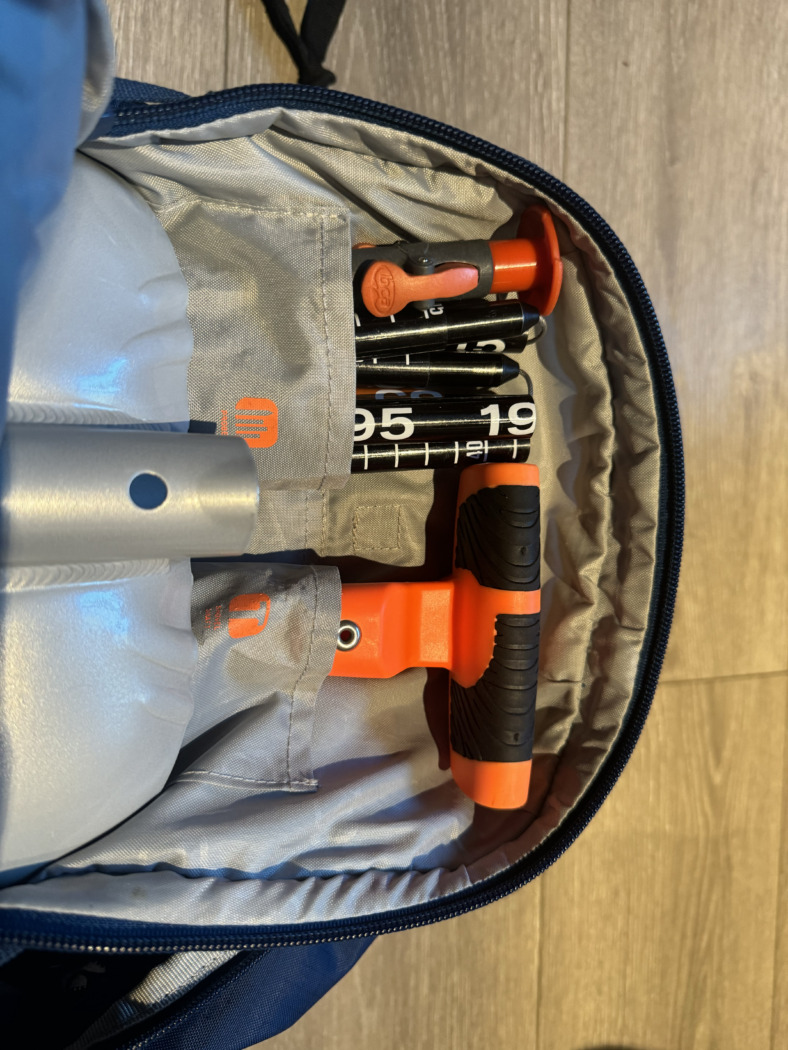
Goldilocks Levels Of Compartmentalization
The outer panel holds avalanche tools with designated sleeves. It fit my widest shovel (the BCA Dozer 2T), no problem.
The panel also features three smaller pockets for organizing essentials, including:
- A deep top pocket, accessed via exterior zip (can be used for goggles and shades if you cram them, but better-suited for tools and treats. More on this below.)
- An internal, spacious velcro and elastic stretch pocket (I used this for lunch and snacks)
- An internal lower zip pocket, just a touch smaller than the elastic stretch pocket (I liked using this for crap that rarely leaves my pack, like a repair kit and a small first aid kit)
All told, the design is measured. There are no superfluous extras—everything serves a purpose.

credit Gloria Liu
A Quad-pack of Critiques
To be honest, I don’t have too many complaints regarding the pack itself, but let’s nitpick:
Handle Woes: I already mentioned that I wished the handle zipped into the backpack strap.
Stash Goggles At Your Own Risk: The goggle pocket (or at least, the zippered top compartment that I assumed was meant to be a goggle pocket, because it’s usually a goggle pocket) isn’t lined with microfiber. I always appreciate a lined, dedicated goggle/glasses pocket, just in case I forget or lose my goggle sack.
But my bigger qualm here is that when your pack is fully loaded, stuffing goggles in that pocket becomes frustratingly difficult. I often resorted to stashing goggles and sunglasses in a case and keeping that in the pack’s main compartment. Not a dealbreaker, but it was enough of an annoyance that I made a note on my phone while touring to include this gripe in my review.
Less Durable Than The BCA Float 35: The exterior fabric doesn’t seem quite as durable as that of the BCA Float 35 E2 I’ve been testing in tandem. Granted, I haven’t had any real durability issues after 25 to 30 days of touring, but it definitely doesn’t come off as bomber or waterproof as the BCA, which has a thicker PU coating. Of course, some might consider this a pro, not a con, since the Ortovox option is significantly lighter while having a higher capacity.
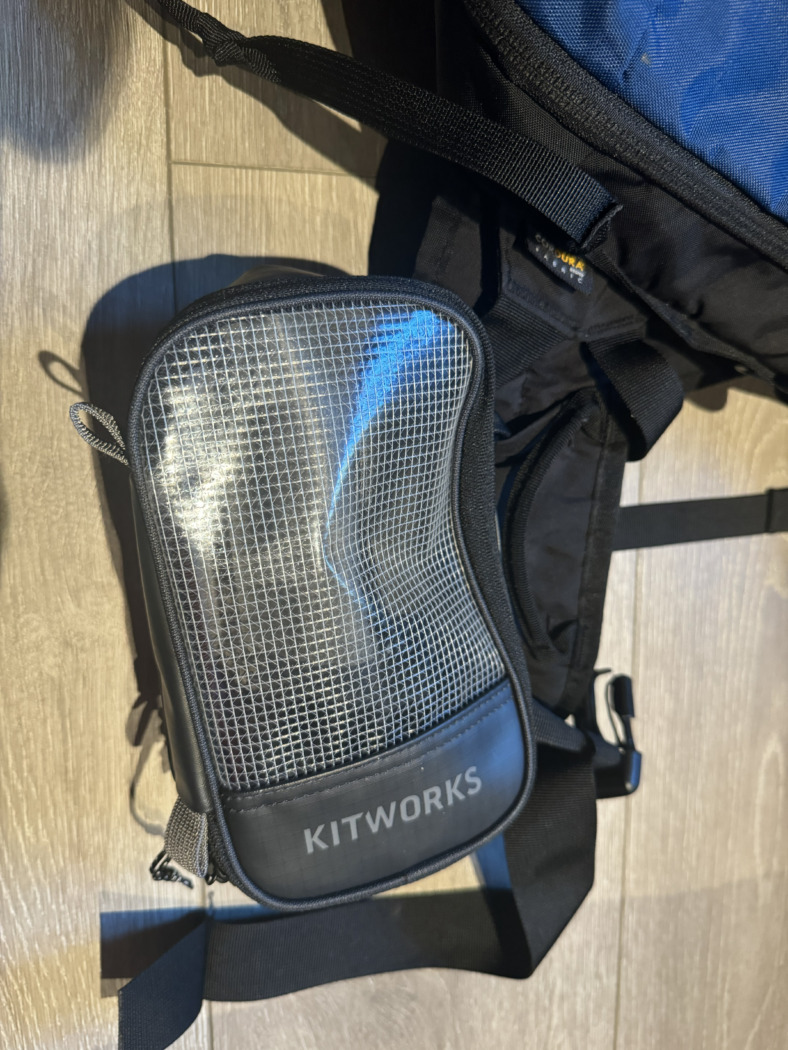
using an aftermarket gear pouch as a hip pocket on the Ortovox Tour 40 pack
No Hip Belt Pocket: My biggest complaint? No hip belt pocket. Sigh. I found that I missed this feature tremendously. Namely, I like to have snacks on hand while I’m touring. I’ll also often keep a scraper in there, a Voile strap, a splitboard tool, maybe a slope meter, etc.
In fact, I missed the hip pocket so much, I actually lashed a little Patagonia Black Hole packing cube to the hip belt during my Norway expedition, so I had three liters of Scandinavian candy (among other things) easily accessible while traipsing through the fjords. It was overkill, sure, but better than nothing.
Adding a hip belt pocket isn’t hard or expensive, but they are better integrated if included in the design. If you get used to having one like I have, you’ll definitely notice the omission.
Final Thoughts on the Ortovox AVABAG LiTRIC Tour 40 Pack
If you’re in the market for an electronic airbag because you want added safety without added grams, the Ortovox Avabag Litric Tour 40 is a great choice. The airbag system itself is as lightweight, reliable, and user-friendly as it gets, and Ortovox’s Tour 40 is cheaper than the Arc’Teryx options that feature the same airbag tech.
The pack itself offers an excellent volume-to-weight ratio and is comfortable for long missions and big days. It’s definitely minimalist with no hip belt pocket and few exterior straps and pouches, but the build is lightweight, and the organization is practical and useful in the field.
The best airbag packs are the ones you use day-in, day-out—you don’t leave it behind on a big day because you’re stressing about weight. Hovering near the five-pound mark, this Ortovox pack has become that daily driver airbag for me. Last week, I took it on the biggest tour of my winter so far (nothing crazy, mind you, but enough that when I came home my boot liners caused my fiancée to gag). At no point during that four-lap affair did I ever think to myself “Damn–I wish I’d brought a lighter pack.”

I’m Drew Zieff. A mountain-loving, powder-chasing, ink-slinging freelance journalist and copywriter. I’ve penned stories for publications such as Outside Magazine, Backcountry Magazine, and Popular Mechanics, among others. Longtime WildSnow reader and now a contributor.

2 comments
Hi Drew, same question as for the Arc’Teryx airbag:
What is the back length?
(Measured from center of waist belt to attachment point of shoulder strap)
That’s amazing you were able to fit all that gear on those bigger kit days! I have a Scott E1 “40 liter” pack and could barely fit my kit for a 5 night hut trip in the alps:
I wear my shells the whole time, so all I had in there was:
0.6 liters of water, mid weight down jacket, warm mittens, goggles, 1 set of socks and undies, an ultralight mid layer vest, silk sleeping bag liner and minimal glacier kit, which fits in a sack the size of a pint bottle, plus a 30m rad line and dyne a cord connecting crampons. 10 bars. Mini totothudh and mini repair kit. No first aid (it was guided).
So quit a bit less than what you were carrying.
I had an extra lpocket made, that I clip to the top, adding about 10 liters, and that just about allowed this stuff to fit.